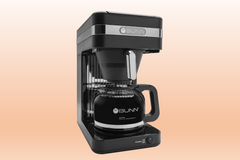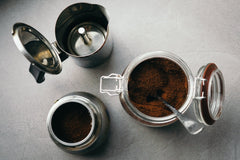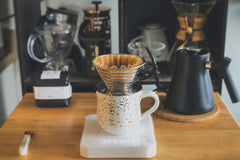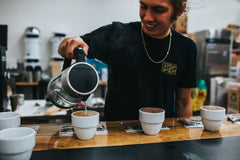
If we were to give you one difference between coffee and espresso and the shortest way to address this dilemma, it would go something like this:
“If it’s espresso, then it’s coffee, but if it’s coffee, it may not be espresso.”
Even though this answers the question in its entirety, we’re sure that it demands more clarification.
Well, espresso is a type of coffee beverage, but also a brewing method and a type of coffee bean.
And coffee (as an agricultural product) can be brewed in many ways, like French press, pour-over, or espresso, to name some — and the result is a coffee drink.
Then again, there are places in the world (Italy, for one) where if you order a cup of coffee, you’ll get an espresso by default.
So what gives?
Let’s explore a few main differences between coffee and espresso that will help you settle any espresso vs. coffee debate as a true coffee espresso connoisseur.
Table of Contents
Espresso vs. Coffee Comparison: An Overview
The main differences between espresso and regular coffee are both physical. An espresso is brewed with finely-ground beans and a high grounds-to-water ratio. Conversely, coffee typically has a more mild flavor due to a more coarsely ground bean and lower grounds-to-water ratio resulting in a less concentrated liquid.
The two most popular types of coffee are espresso and drip coffee. Though there is considerable difference in quality and price, it's not uncommon for consumers to mix and match between the two brew types in an effort to save money. While there is no right or wrong answer when it comes to deciding which type of coffee to drink, understanding how each grows and reflects the ecosystem in which it grows is essential.
Espresso is essentially a product of single-serve brewing—the traditional method used to make an espresso drink (and many other types of hot drinks). Filter coffee goes through a series of steps before being brewed; some steps are involved solely for making espresso, while others are relevant to making any type of drink.
Black coffee and espresso roast are both made by removing the water and most of the grain from a roasted coffee bean. What remains is the essence of what was once in the bean - the flavor, aroma, and texture are all preserved. Water soluble ingredients like sugar, salt, and flavors cannot be completely removed without affecting the flavor or taste of the brewed coffee.
Espresso the Drink vs. Espresso the Brewing Method
We’ve established that espresso is a type of coffee drink.
But it’s also a brewing method in which finely ground coffee beans are exposed to a high pressure of hot water. This results in a delicious, rich-in-flavor shot of caffeine goodness — that’s espresso, the drink.

When you make espresso, you have a base for many other coffee drinks due to the espresso brewing method.
Combine it with milk or water, and it will transform into a macchiato, cappuccino, americano, or some other delicious espresso-based beverage.
The Special Brewing Method
Every brewing method, in its essence, is the same — the extraction of the coffee bean’s soluble components into the water to make the magical drinking potion that helps us tackle sleepy mornings and daily tasks.
There are many brewing methods of preparing regular coffee; some of them are:
- Turkish brew
- French press
- Pour-over (manual and machine)
- Vacuum / siphon pot
- Coffee bag
But to make espresso, you need to have the proper equipment (an espresso machine) and some know-how.
Dating from the beginning of the 20th century, espresso-making has developed into an art form, and pulling a shot (making espresso) was perfected along with the accompanying machinery.
The equipment we’re talking about is the one you can see your favorite barista working with while churning out fresh cups of espresso every 30 seconds (average time for preparing espresso) — and that takes skill.

But today, you can buy espresso machines for your home or office that are easy to work with, and enjoy drinking a shot of creamy caffeine goodness whenever you want.
And to experience a truly delicious espresso, be sure to use freshly roasted coffee beans.
Espresso Beans
One other term espresso is used for is when talking about coffee beans, or to be more precise — the roasting times of coffee beans.

Espresso beans are easy to recognize because compared to regular coffee beans, they have a darker shade of brown. That color results from a longer slow-roast process that helps bring out the flavor and reduce acidity.
Crema — the Secret of Freshness
To differentiate a quality cup of espresso from regular coffee and impress your friends with some knowledge, look for the frothiness on top of the coffee drink known as: crema.
Crema forms as a reaction to the high-pressure brewing process in which the dissolved CO2 (produced during the roasting) comes in contact with the coffee liquid and produces bubbles that then react and create a creamy layer.
Thick crema is a sign of a perfectly brewed and tasty espresso, and it also uncovers some interesting facts about the coffee it’s made from.

Firstly, if the coffee beans used to make the espresso weren’t freshly roasted, meaning that the coffee used is older, you won’t have a good crema.
Secondly, by observing the color of the crema, you can tell how strong the coffee is. If your espresso has a rich and dark-colored crema, that means it’s stronger.
Thirdly, if your cup of espresso doesn’t have crema, but you know that freshly roasted beans were used, that indicates that something went wrong in the brewing process.
Is Espresso Stronger Than Regular Coffee?
Yes, espresso is stronger, but it doesn’t mean you’ll consume a larger amount of caffeine by drinking espresso.
The question of espresso vs. other coffee brews in regards to higher caffeine intake levels requires us to take a look at some numbers in the table below.
| Type | Serving size | Caffeine per serving | Caffeine per ounce |
| Drip Coffee | 8 fl. oz. | 65-120 mg | 8.13 mg - 15 mg |
| Brewed Coffee | 8 fl. oz. | 95 mg | 11.88 mg |
| Cold-brew Coffee | 16 fl. oz. | 200 mg | 12.5 mg |
| Espresso | 2 fl. oz. (1 shot) | 60 - 102.67 mg | 30 - 51.34 mg |
As you can see, espresso contains a higher concentration of caffeine-per-ounce than an average cup of drip coffee or other brews on the list.
But it’s important to note that by drinking three-to-five average cups of drip coffee, you consume more caffeine than by drinking three-to-five shots of espresso.
So the difference between espresso brewed and regular coffee in regards to caffeine is more a matter of the quantity you drink than what you drink.

Espresso is meant to be consumed as a shot. You could have more than one at once, but don’t overdo it; we don’t want you to get the jitters.
Is Espresso Better for Your Stomach Than Coffee?
During the espresso brewing method, hot water runs through coffee grounds with high pressure for no more than 30 seconds. Because of this, fewer stomach-irritating substances are released into the drink.

So the espresso is actually easier on your stomach than other coffee brews.
And if you’re worried about the natural level of acidity in the coffee — well, as we mentioned, espresso blends are medium or dark roast. They have even less acidity because acid breaks down more the longer a bean is roasted.
Coffee and Espresso — the Final Verdict
As you may have noticed, we didn’t say that espresso is better than other types of coffee or vice-versa.
That’s simply because we at Nomad Coffee Club love all coffee and care more for the quality of beans and freshness of the roast, no matter how it’s prepared.
So what’s the final verdict?
Prepare your favorite cup of joe, whatever it may be, and enjoy.
Become a Member of the Nomad Coffee Club
Waking up in the morning and preparing a cup of fresh, tasty coffee is a special and enjoyable daily ritual all coffee lovers share. We’re proud to be a part of your day, as we’re not just a coffee company.

Monthly Coffee Subscription Plan
By joining our prepaid subscription program, every month, you’ll get to enjoy a different, perfectly roasted single origin or blend coffee — 100% organic and non-GMO — sourced from across the world.
And not only that, but by becoming a Nomad, you help support our farmers’ community development.
Each purchase helps support fair wages and projects protecting our planet from climate change.
Become a Nomad, join us today!






